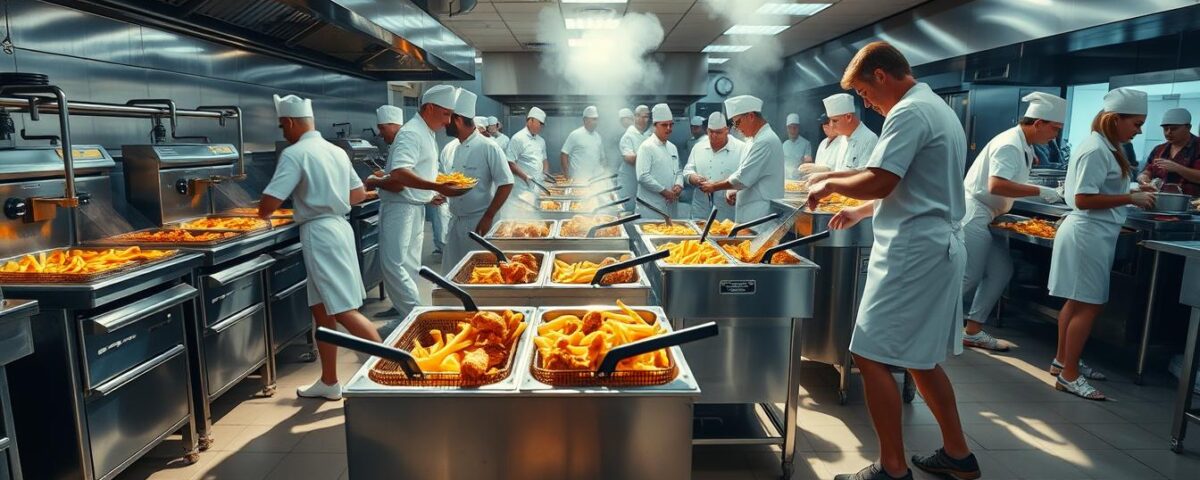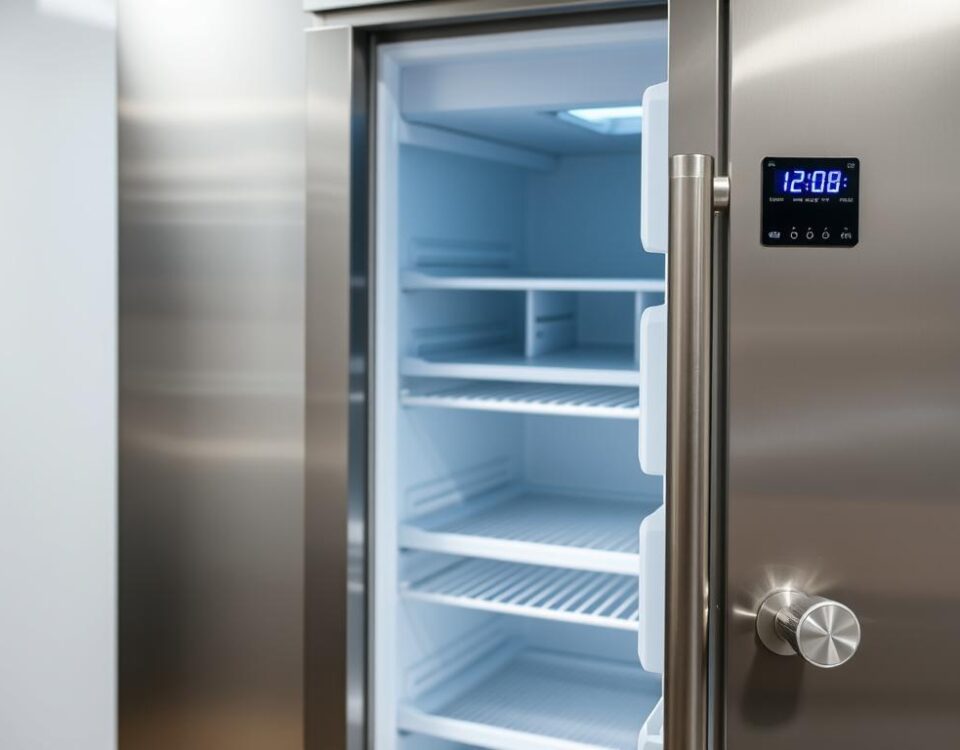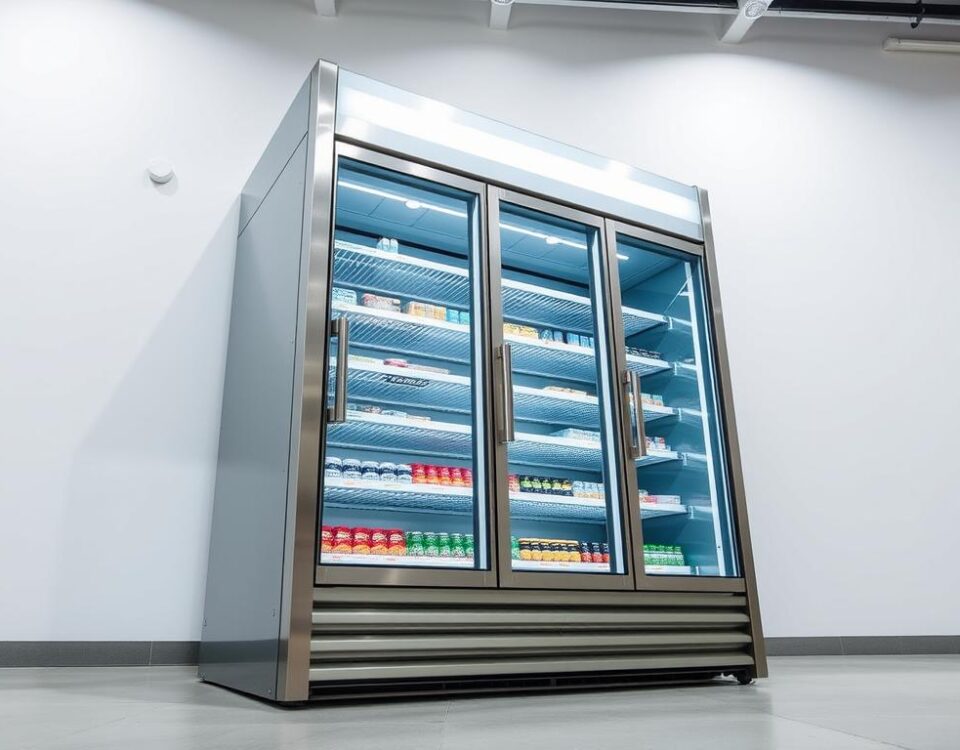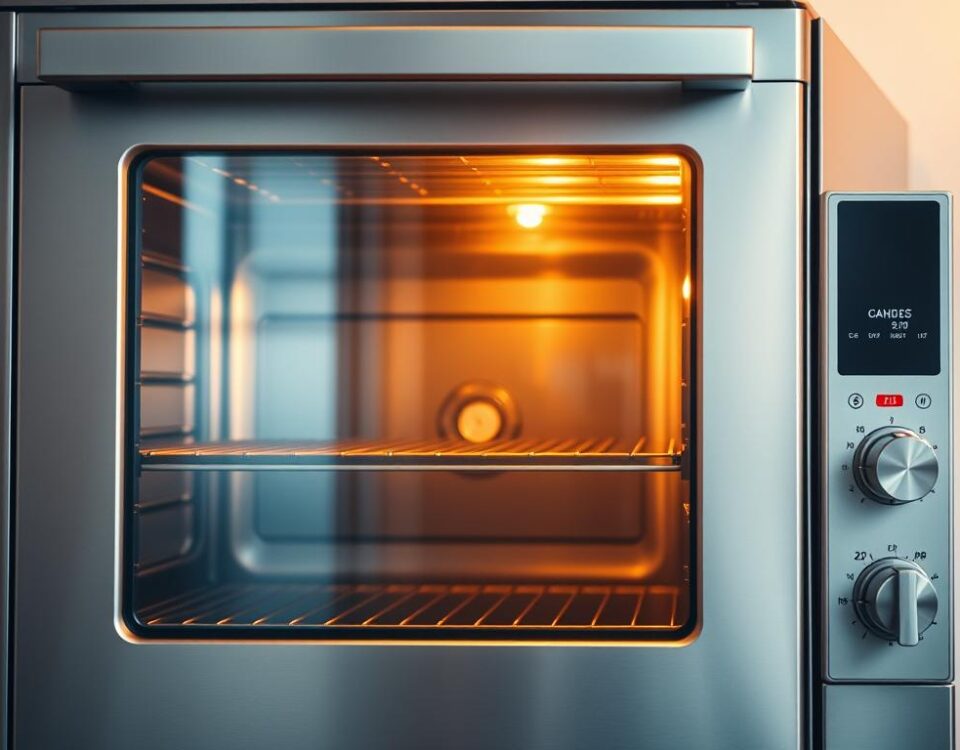
Which Commercial Dishwasher Actually Saves Time and Water? I Tested Them All
September 10, 2025
5 Commercial Fryers Entered the Kitchen—Here’s the One That Won
September 11, 2025In the fast-paced environment of a commercial kitchen, the right cooking equipment can make all the difference. I recall a busy restaurant where the chefs struggled with a countertop fryer that couldn’t keep up with the demand, leading to delayed orders and frustrated customers. Did you know that a well-chosen fryer can increase kitchen efficiency by up to 30%?
As a kitchen manager, selecting the right commercial fryer is crucial. The debate between floor model and countertop fryers is ongoing, but the benefits of choosing the right one are clear. So, what makes fryers a critical component in busy kitchens?
Key Takeaways
- Floor models offer higher capacity and efficiency for busy kitchens.
- Countertop fryers are limited by their size and heat recovery capabilities.
- The right fryer can significantly impact food quality and customer satisfaction.
- Commercial fryers come in various types, including natural gas, propane, and electric.
- Understanding the differences between fryer types is crucial for informed decisions.
Understanding Commercial Fryer Basics
Understanding the basics of commercial fryers is essential for any kitchen that aims to serve high-quality fried foods consistently. Commercial fryers are a staple in many restaurants and fast food establishments, playing a critical role in preparing a variety of menu items.
The Importance of Choosing the Right Fryer for Your Kitchen
Selecting the right commercial fryer is crucial for kitchen efficiency and food quality. The type of fryer you choose can significantly impact your kitchen’s workflow, staff productivity, and operational costs. For instance, countertop fryers are ideal for smaller kitchens or for frying limited quantities of food, while floor models offer more capacity and better temperature recovery, making them suitable for high-volume kitchens.
Common Fryer Applications in Commercial Kitchens
Commercial fryers serve as the backbone of many restaurant operations, particularly those specializing in fried foods. They are used in various food service environments, from fast food chains to fine dining establishments, for frying a range of items including chicken, french fries, and appetizers. The right fryer can enhance food quality, reduce cooking times, and increase kitchen productivity.
Floor Model vs Countertop Fryer: Key Differences
Understanding the distinctions between floor model and countertop fryers is crucial for optimizing your kitchen’s frying capabilities. The primary differences lie in their size, capacity, output, and installation requirements.
Size and Capacity Comparison
Countertop fryers are designed to be compact, taking up minimal space but offering limited capacity. In contrast, floor fryers have larger footprints and can handle substantial frying demands, making them ideal for high-volume establishments. The widths of these fryers can range from 11″ to 34,” with some models extending up to 94″. Capacities can reach up to 500 lbs, with tank capacities measured in pounds or maximum oil volume.
| Fryer Type | Width Range | Capacity Range |
|---|---|---|
| Countertop Fryer | Compact, typically narrower | Limited, suitable for low to moderate volume |
| Floor Fryer | 11″ to 34,” some up to 94″ | Up to 500 lbs, high volume capable |
Output and Production Capabilities
Floor model fryers typically offer significantly higher volume potential compared to countertop models. This difference in output capability is crucial for kitchens that need to handle peak service periods efficiently. The larger capacity of floor fryers allows for more food to be cooked simultaneously, improving overall kitchen productivity.
Space Requirements and Installation Considerations
While countertop fryers offer flexibility and require minimal installation, floor model fryers often necessitate dedicated gas lines and ventilation systems. The size and installation requirements of floor fryers mean that kitchen planners must consider both current needs and future growth potential when deciding between these two types of fryers.
The choice between a floor model and a countertop fryer ultimately depends on the specific needs of your kitchen, including available space, expected frying volume, and the type of food being prepared. By understanding these key differences, you can make an informed decision that enhances your kitchen’s efficiency and productivity.
Why Floor Models Excel in High-Volume Operations
In the fast-paced environment of commercial kitchens, floor model fryers stand out for their ability to handle high-volume frying operations efficiently. Their design and capabilities make them particularly suited for kitchens that require a high output without compromising on the quality of the fried food.
Superior Heat Recovery Between Batches
One of the critical advantages of floor model fryers is their superior heat recovery between batches. This is particularly important in busy service periods when continuous frying is required. Gas fryers, in particular, produce much higher BTUs per hour, allowing the oil to heat up quickly and maintain cooking temperatures. This rapid recovery ensures that the fryer is ready for the next batch of food without significant downtime, thus increasing overall productivity.

Consistent Cooking Temperatures for Better Results
Floor model fryers maintain more consistent cooking temperatures even under heavy use, resulting in more uniform food quality and fewer rejected items. The larger oil capacity in these fryers helps in maintaining a stable temperature, which is crucial for achieving consistent frying results. This consistency is key to delivering high-quality food to customers, enhancing their satisfaction and loyalty.
Handling Larger Food Items with Ease
The larger capacity of floor model fryers allows for cooking bigger food items like whole chicken pieces that might be challenging in countertop units. This capability is particularly beneficial for restaurants that offer a variety of fried foods, including larger items. The flexibility to cook a range of food sizes and types without compromising on quality is a significant advantage of floor model fryers.
| Fryer Type | Heat Recovery Time | Cooking Capacity |
|---|---|---|
| Floor Model Fryer | Fast | High |
| Countertop Fryer | Slow | Limited |
Fuel Options: Gas vs Electric Commercial Fryers
Selecting the right fuel type for commercial fryers is essential for optimizing kitchen performance and reducing operational costs. The choice between gas and electric models can significantly impact cooking efficiency, energy consumption, and overall kitchen workflow.
Natural Gas and Propane Advantages for Floor Models
Natural gas and propane are generally considered more efficient and cost-effective fuel options for commercial fryers, particularly for floor models used in high-volume operations. Gas fryers heat up quickly and reach higher maximum temperatures, allowing for faster cooking times and better food quality. This is especially beneficial in busy kitchens where speed and consistency are crucial.
However, gas fryers require a natural gas line connection, which can limit their mobility and necessitate additional installation costs. Despite this, the advantages of gas fryers make them a popular choice for many commercial kitchens.
When Electric Fryers Make Sense
While gas fryers offer several performance advantages, electric fryers have their own set of benefits that make them suitable for certain kitchen environments. Electric fryers are more mobile and easier to install since they don’t require a gas line connection. They also feature multiple heating elements that come into direct contact with the frying oil, allowing for quick recovery times between batches.
Electric fryers are particularly suitable for locations without gas infrastructure or in kitchens with specific ventilation constraints. They offer a viable alternative when gas fryers are not feasible, ensuring that kitchens can still achieve high-quality frying results.
Heat Distribution Systems and Their Impact
Understanding the different heat distribution systems in commercial fryers is essential for achieving consistent cooking results. The heat distribution system significantly affects the fryer’s performance, influencing factors such as cooking time, food quality, and oil degradation.
Tube-Type Fryers for High-Sediment Foods
Tube-type fryers are particularly effective for cooking high-sediment foods like breaded chicken or fish. These fryers use tubes to heat the oil, creating a larger cold zone that prevents sediment from burning and thus maintaining oil quality. The design ensures that the oil is heated evenly, reducing the risk of hotspots that can degrade the oil.
Open Pot Design Benefits and Limitations
Open pot fryers, on the other hand, are ideal for cooking low-sediment foods. They offer a larger hot zone, which allows for faster cooking times. However, the smaller cold zone can lead to sediment burning if not managed properly. Open pot designs are also generally easier to clean than tube-type fryers.
Specialized Heat Distribution Options
Specialized heat distribution options, such as flat-bottom fryers, are designed for specific cooking tasks. For instance, flat-bottom fryers are popular for cooking donuts and funnel cakes, as they provide a uniform heat distribution that is crucial for these foods. Understanding the specific needs of your menu items can help in selecting the right fryer.
| Fryer Type | Best For | Key Benefits |
|---|---|---|
| Tube-Type | High-sediment foods (breaded chicken, fish) | Larger cold zone, even heating |
| Open Pot | Low-sediment foods | Faster cooking, easier cleaning |
| Flat-Bottom | Specific foods (donuts, funnel cakes) | Uniform heat distribution |
Selecting the right heat distribution system depends on several factors, including menu offerings, volume requirements, and operational considerations like cleaning and maintenance. By understanding the strengths and limitations of each type, commercial kitchens can make informed decisions to optimize their frying operations.
Countertop Fryers: When They’re the Right Choice
In kitchens with limited space or specific frying needs, countertop fryers prove to be the ideal solution. These compact fryers are perfect for frying limited quantities of smaller food items such as french fries, onion rings, or small orders of chicken wings.
Space-Constrained Kitchens and Mobile Operations
Commercial countertop fryers are frequently used in locations with limited floor space, such as food trucks, small cafes, and kiosks. They are ideal for mobile operations or kitchens where space is at a premium. The compact footprint allows for efficient use of available space without compromising on frying capacity.
Supplementary Frying for Limited Menu Items
In larger kitchens, countertop fryers can serve as supplementary cooking equipment, handling specialty items or providing backup capacity during peak periods. This flexibility is particularly useful for kitchens with varied menus or those that experience fluctuating demand.
When selecting a countertop fryer, consider factors such as capacity, fuel type, and features. For smaller operations, a countertop fryer may be the most cost-effective solution, providing the necessary frying capability without the investment in a larger floor model.
Maintenance and Cleaning Considerations
To ensure optimal performance and extend the life of commercial fryers, regular cleaning and maintenance are essential. Both floor model and countertop fryers require attention to maintain their efficiency and the quality of the food they produce.
Daily Cleaning Requirements for Both Types
Daily cleaning is vital for removing food sediment and ensuring the taste of the oil is not compromised. For both types of fryers, cooking oil should be filtered at least once a day, with more frequent filtration for high-volume frying operations. A full cleaning of the fryer between shifts is also recommended to remove all food particles from the frypot.

Oil Filtration and Management
Oil filtration systems play a crucial role in extending oil life and maintaining food quality. While both floor model and countertop fryers can be equipped with filtration systems, the design and implementation may vary. Proper oil management practices are essential for maximizing oil lifespan and ensuring consistent frying results.
| Fryer Type | Filtration System | Oil Life Expectancy |
|---|---|---|
| Floor Model | Built-in filtration | Up to 20% longer |
| Countertop | Manual or portable filtration | Standard |
Long-Term Maintenance Differences
The long-term maintenance of floor model and countertop fryers differs primarily in component replacement and service requirements. Floor model fryers, with their more complex heating systems, may require more frequent maintenance checks compared to countertop models. For instance, fryers that heat with tubes can be more difficult to clean and may require specialized brushes.
By understanding these differences and implementing effective cleaning and maintenance routines, kitchen operators can maximize equipment life and performance while minimizing downtime.
Making the Final Decision for Your Kitchen
Selecting the ideal fryer for your restaurant or hotel kitchen is a crucial decision that affects your menu offerings and operational efficiency. The choice between a floor model and a countertop fryer depends on several factors, including your menu, volume requirements, available space, and budget.
For high-volume establishments, floor fryers are often the better choice due to their ability to handle daily, consistent use. They offer superior heat recovery between batches and can cook larger quantities of food items like french fries and chicken efficiently. On the other hand, countertop fryers are more suitable for kitchens with limited space or for preparing smaller quantities of food.
To make an informed decision, evaluate your current needs against future growth potential. Consider calculating the return on investment for different fryer types based on your menu offerings, volume projections, and operational costs. When ready to make a purchase, key specifications to consider include the fryer type, cooking volume, and energy efficiency.
By carefully weighing these factors and understanding the advantages of each fryer type, you can make a decision that enhances your kitchen’s efficiency and supports your business goals.
FAQ
What type of fryer is best for a busy kitchen with high-volume frying needs?
I recommend a floor model commercial fryer, as it can handle large quantities of food and provides superior heat recovery between batches, ensuring consistent cooking results.
How often should I clean my commercial deep fryer?
A: Daily cleaning is essential to prevent the buildup of debris and bacteria. I suggest cleaning the fryer after every use, and performing a deep clean at least once a week to maintain optimal performance and hygiene.
What are the benefits of using a natural gas commercial fryer?
Using a natural gas commercial fryer offers several advantages, including faster heat recovery, precise temperature control, and lower operating costs. Additionally, natural gas fryers are ideal for high-volume kitchens, as they can handle large quantities of food with ease.
Can I use a countertop fryer for frying large or heavy food items?
While countertop fryers are convenient, they may not be suitable for frying large or heavy food items. I recommend using a floor model commercial fryer for such tasks, as it provides more space and can handle larger quantities of food.
How do I choose the right size of commercial fryer for my kitchen?
To choose the right size, consider the volume of food you need to fry, the available space in your kitchen, and the type of food you’re cooking. I suggest consulting with a commercial kitchen expert to determine the best size and type of fryer for your specific needs.
What are the key differences between tube-type and open pot deep fryers?
Tube-type deep fryers are ideal for high-sediment foods, as they provide a more efficient heat distribution system. Open pot deep fryers, on the other hand, offer more flexibility and are easier to clean. I recommend considering your specific frying needs when choosing between these two types.
How can I ensure consistent cooking temperatures in my commercial fryer?
To ensure consistent cooking temperatures, I recommend investing in a high-quality commercial fryer with advanced temperature control features. Regular maintenance and cleaning are also crucial to maintaining optimal performance.



